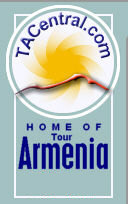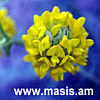 |
||||||||||||||||||||||||||||||||||
|
||||||||||||||||||||||||||||||||||
|
||||||||||||||||||||||||||||||||||
|
|||||||||||||||||||||||
 |
|||||||||||||||||||||||
| - | |||||||||||||||||||||||
|
||||
The Ararat Valley is one of the oldest settled areas in the ancient world, as excavations in suburban Yerevan illustrate. A 90,000 BCE Stone Age settlement was uncovered on the shores of Lake Yerevan opposite Shengavit, exposing hunting tools and implements made from obsidian, crude mudpack and cave dwellings, and the earliest religious artifacts uncovered on the Armenian Plateau. Settlements quickly grew in the Copper Bronze Age along the entire length and width of the valley, based on a change from hunting and gathering to collective farming sometime between 15,000 - 10,000 BCE. Virgin strands of wild wheat still propagate in the valley between Yerevan and Garni. The wheat is the closest thing we have to that which ancient man first cultivated on a large scale. Carbon dating of wheat kernels uncovered at excavations along the Ararat Valley show large-scale wheat cultivation as far back as 15,000 BCE. The valley’s volcanic base produced extraordinarily diverse minerals and metal ore as well, including pure strains of silver, gold, tin and copper. The forging of tin and copper into bronze occurred in the Ararat Valley as early as 5000 BCE, and the first known casting of iron occurred around 2000 BCE. The combination of agriculture development and metallurgy created a sophisticated culture that predates almost all others in Western Asia and the Middle East. The nucleus was Metsamor, a city of 50,000 people by the mid Bronze Age. Others were Lechashen at Lake Sevan (possibly the site of Gegh), Garni, Shengavit, Jerahovit, AdaBlur, MokhraBlur, Aigeshat and Yervandashat. Frequent raid and border wars leveled cities, which were rebuilt in layers on top of previous rubble, allowing archeologists to uncover generations of splendor and decline. By the Urartian period, the area was extensively populated, with a large network of roads connecting the regions. Cuneiform found in all the regions of the republic indicate that civilization as classical historians coin it, had developed to a high degree. Primary Urartian cities included Argishtikhinili (Armavir), Teishebaini (Karmir Blur) and Erebuni, which is considered the beginning of Yerevan's history as a city. Heavily timbered in previous centuries, hillsides lining the valley were deforested by the Urartu period, so that additional irrigation canals had to be installed to support the agricultural system. During the Persian, Hellenistic and Roman periods, settlements grew to large cities, including Armavir, Artashat and Vagharshapat. By this period the Ararat Valley was extensively irrigated, providing an abundance of food. It is not known how many people lived in the republic at this time, but it was a strategic trade and political fulcrum for outside powers, and the city of Artashat was considered the "Cartage of the East," indicating it was not a backwater country. The greatest threat to human ecology was constant warfare and threat of invasion, which stretched from the Roman through the modern era. Extensive expansion of towns and contruction of churches and monasteries began in the 5th century, continuing up to the Ottoman and Persian division of the kingdom in the 16th-17th centuries. The monastery communities did not coincide with rapid urban development countrywide, as it did in other countries. The urban areas grew primarily at Ani, Dvin and Kapan, with Ani supporting a population of 100,000, larger than any city in Europe at that time. The Ararat Valley continued to support heavy agriculture production, though the southernmost and easternmost areas had by now become a desert. The rise of monastic communities, academies and small towns in the mountainous regions were likely due as much to more abundant resources as they were to threat of invasion. The 19th century, when the Russian Empire usurped Persian hegemony over Eastern Armenia, marks the beginning of both a surge in population growth and depletion of natural resources. The Russians fostered large exploitation of mineral resources, and it is at this time that French, German and Swiss firms began mining the country's extensive gold, diamond and metal resources on a large scale. Giumri was designated the regional capital (then named Alexandrople after Alexander I), and the population at Yerevan was a mere 14,000. By the early 20th century, Yerevan had grown to approx. 45,000, and the most serious Human Ecology threats were about to begin. Tamanian designed the new Armenian capital for a then unheard of 150,000 people. In 50 years, the sleepy town of Yerevan had grown to a metropolis of one and half million people working in mostly huge industrial complexes. The period following World War II is marked by huge urban development and industrial development, and the greatest threats to the environment ensued. While Soviet Armenia reclaimed much of the desert and scrub land on the edges of the Ararat Valley, they did this by depleting the waters in sensitive areas. The vast underwater lake that lies below Yerevan was rendered useless due to pollution and toxic waste disposal, and chemical and metal processing plants in Yerevan, Vanadzor and Alaverdi did greater damage to the environment than the deforestation of the recent past.
Beginning in 1990, Armenia saw a real decline in its population, which has created a critical mass of decline for economical development. Officially the government admits to an 8% unemployment rate and decline of 750,000- 1.5 million of its population (migrated to other countries searching for work). In fact, the unemployment figures are based on worker roles for factories that no longer operate, and the unemployment rate is closer to 80% of the population. However, the bulk of these factories will never be able to replicate their bloated staffing and remain competitive in the world market, and the burgeoning private sector (also called the "Black Market") makes up much of the difference, with the UN estimating off the record that 50-70% of the population are really unemployed and vulnerable. Even those figures are guesswork, since a census has not been made since 1989, and every urban area of the country has seen real loss of population. It is much more likely that over a million people have left the country in search for work, sending back support funds to families left behind. As much as 250 million dollars a month are sent into the country from Armenians living abroad. The threats to human ecology are a mixed bag. Shutting down factories and migrations outside has relieved the pressures on the environment, but as the economy grows, rational use of resources is not being utilized. Yerevan has experienced a small boom in the past several years, and locals are already complaining of the smoggy skies, worst July to October and December to March, when fossil fuel emission hangs in the air. Irrigation still uses the least effective way of watering plants, and the pressure exerted by the Azerbaijan/Turkey energy blockade against Armenia forces overuse of hydroelectric capacity and prompted the reopening of the Metsamor Atomic Reactor, shut down during the green movement in 1988. Despite a much smaller population of 1.7 - 2.5 million, the relentless search for income leaves ecology far behind in the thoughts of the people. The Greens movement that sprung in the 1980's and forced the shutdown ot the Metsamor nucleur reactor and Nairit petrochemical plant, fostered a number of Ecological organizations (Nongovernmental Organizations, or "NGO's"), which continue to fight to protect the environment despite overwhelming odds and virtual neglect by Armenians abroad, the most capable to help. Eco-NGO's are spearheading education, public awareness and conservation efforts, which may prove to be the only means to pass a beautiful and rich ecosystem on to the next generation.
Images (photos
by Tigran Nazarian) Weather Forecasts
INDIVIDUAL REPORTS
|
| |
Search | |
||||||



![[boy]"](storypage/storyimages/uploaded18boy.jpg)